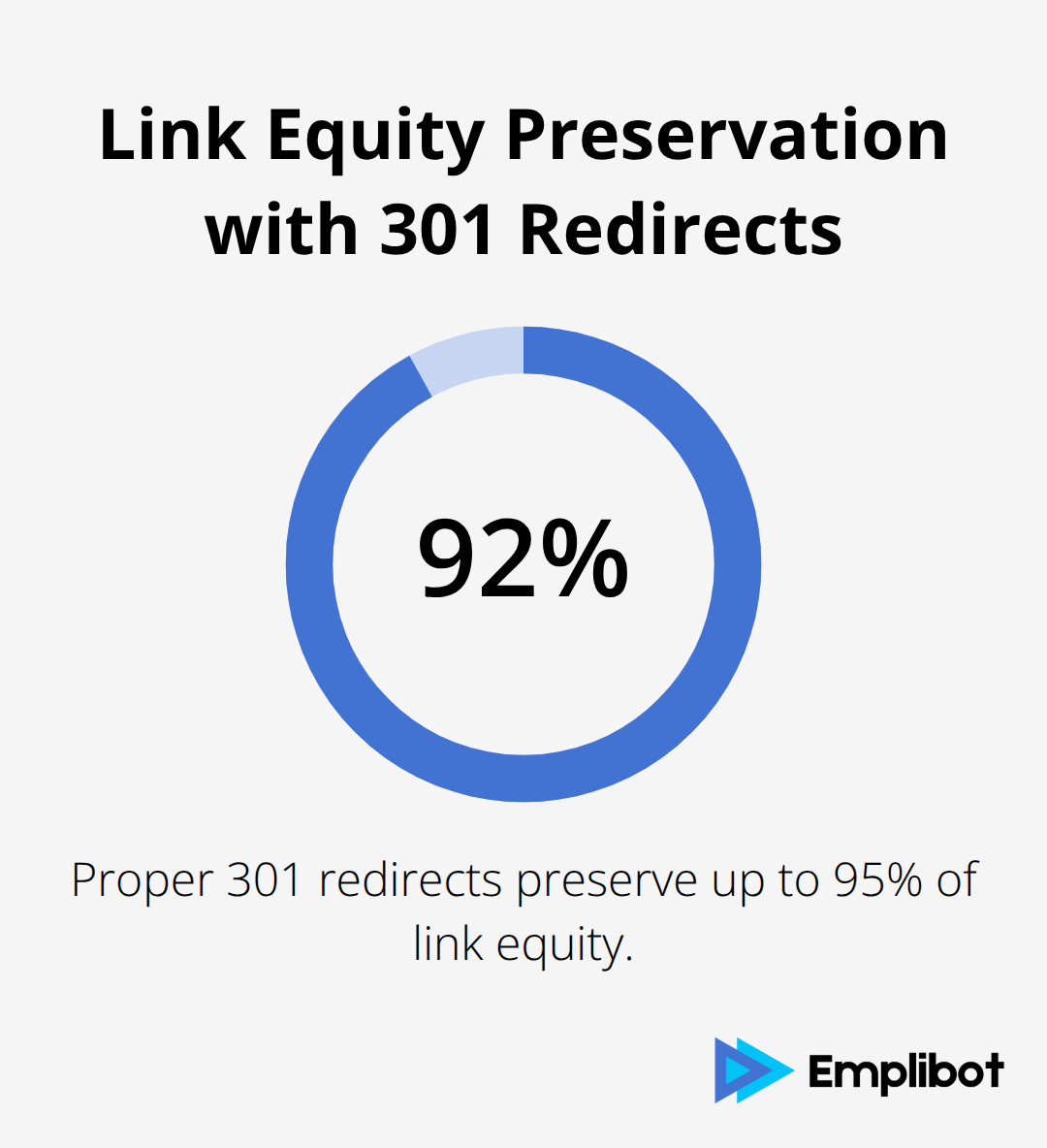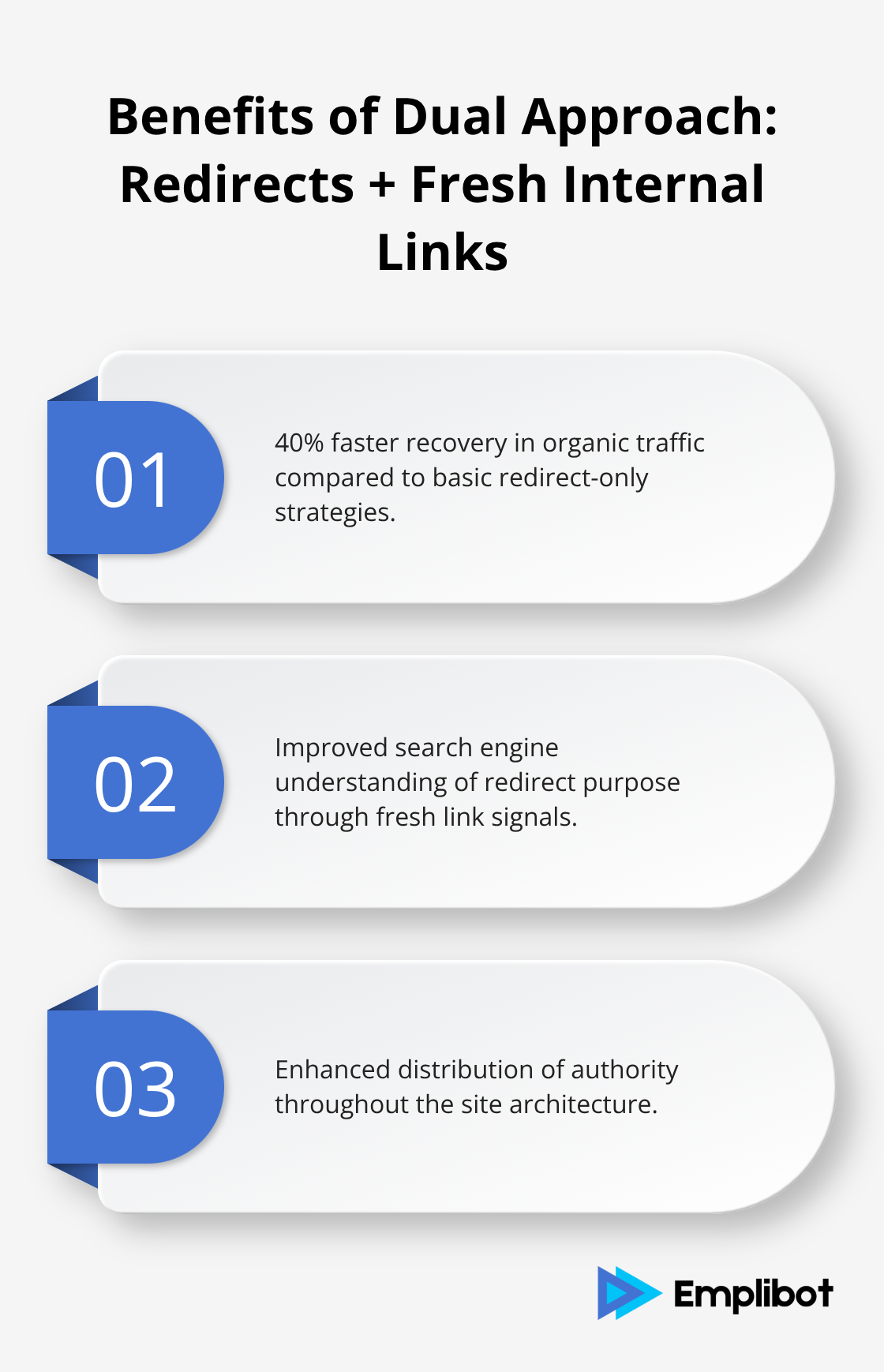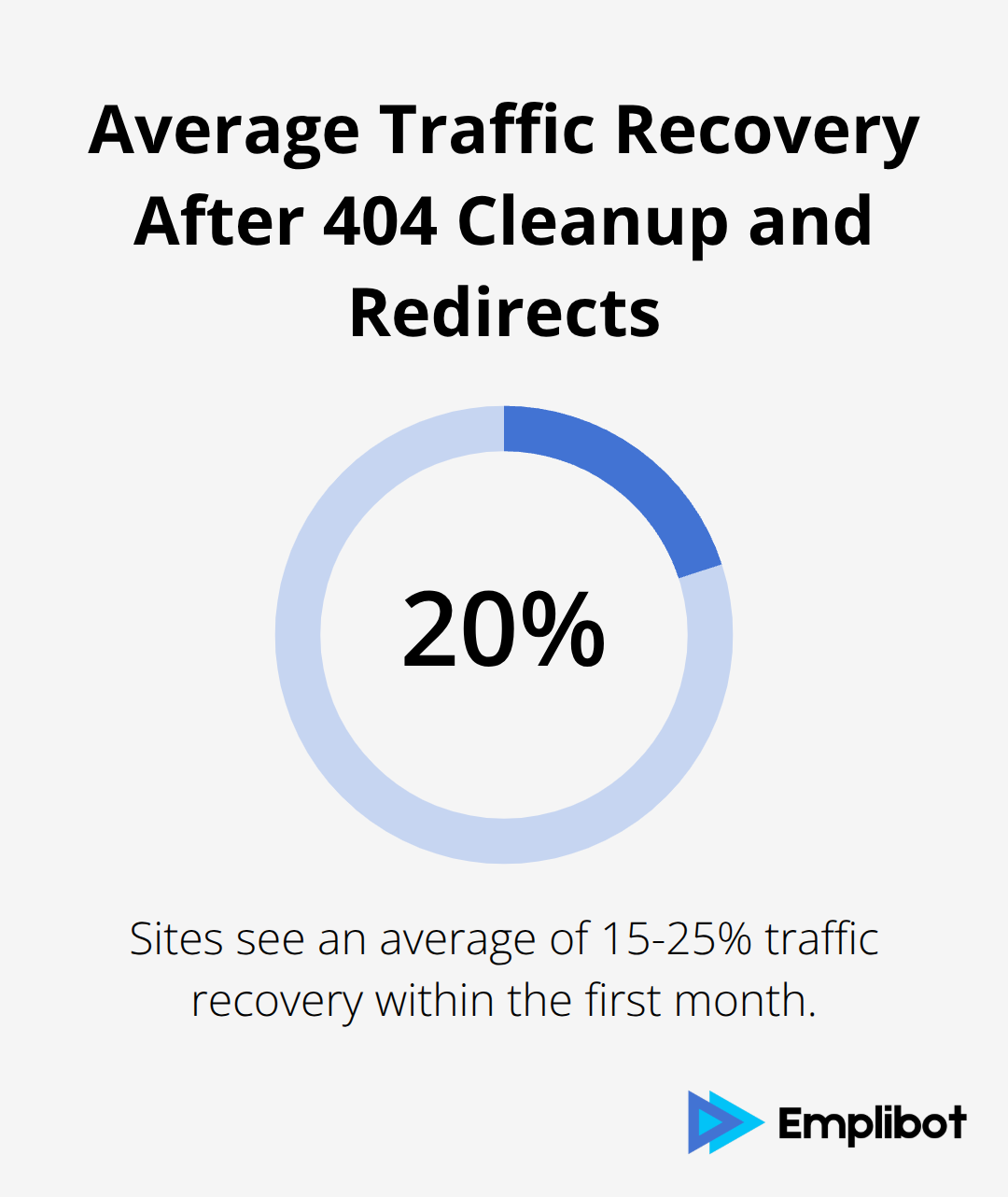Broken pages drain your website’s SEO potential and frustrate visitors. Most sites accumulate hundreds of 404 errors over time, creating a maintenance nightmare that manual fixes can’t solve.
We at Emplibot see this challenge daily. Smart 404 cleanup and redirects require automation, strategic thinking, and systematic execution to recover lost traffic at scale.
How Do You Find and Fix 404s Automatically
Automated 404 detection starts with systematic weekly crawls that use tools like Screaming Frog or Sitebulb to scan your entire site structure and identify broken internal links. Google Search Console provides another detection layer through its Coverage report, which shows 404 errors that Google encounters during crawls. Server log analysis reveals the complete picture by capturing all 404 requests, including those from external links and user bookmarks that crawl tools miss.
Pattern Recognition Saves Hours of Manual Work
Smart 404 management groups similar errors by URL patterns rather than handles each broken link individually. URLs with common structures like /blog/2019/, /products/discontinued/, or /old-category/ often break together when site architecture changes. These patterns allow batch processing of hundreds of redirects simultaneously. Traffic analysis from Google Analytics reveals which 404s actually matter – pages that receive organic search traffic or backlinks from high-authority domains should receive immediate attention, while zero-traffic orphaned pages can wait.
Priority Matrix Focuses Your Efforts
High-impact 404s combine significant traffic loss with strong backlink profiles (according to Ahrefs data). Pages that previously generated 1000+ monthly visits or hold backlinks from domains with authority scores above 50 demand immediate 301 redirects. Medium-priority errors include pages with 100-999 monthly visits or moderate backlink strength. Low-priority 404s affect pages with minimal traffic history and weak link profiles, which makes them candidates for delayed fixes or permanent removal through 410 status codes.
Traffic Impact Assessment Drives Decision Making
Analytics data determines which broken pages deserve your attention first. Pages that drove substantial organic traffic in the past six months represent lost revenue opportunities that 301 redirects can recover. External backlink analysis through tools like Ahrefs or Majestic shows which 404s still receive link equity from other websites – these pages transfer their authority to new destinations through proper redirects.
Proper 301 implementation preserves 90-95% of the original page’s link equity according to Google’s John Mueller, but only when the destination page maintains topical relevance. Server-level redirects through .htaccess files outperform plugin-based solutions and reduce response time by 200-400 milliseconds.

The next step transforms this data into actionable redirect strategies that preserve SEO value while improving user experience.
How Do You Map 404s to Perfect Redirect Destinations
Smart Auto-Mapping Beats Manual Guesswork
Automated 404 systems analyze URL structure, content themes, and user intent to match broken pages with relevant hub pages. Tools like Botify and DeepCrawl scan your site architecture to identify topical clusters and category relationships that manual review would miss. Content similarity algorithms compare the broken page’s cached content from Internet Archive against your current pages, then score matches based on keyword overlap and semantic relevance.
AI can automate many SEO tasks, analyze data in real-time, and predict trends, making processes more efficient and accurate. Hub pages with broad topical coverage and strong internal link structures serve as ideal redirect destinations because they can accommodate diverse user intents from the original broken pages.
301 Redirects Transfer Maximum SEO Authority
WordPress sites benefit from bulk redirect uploads that use CSV files to map old URLs to new destinations in single operations rather than individual redirect creation. This approach handles hundreds of redirects simultaneously and eliminates the tedious process of manual entry.
Fresh Content Links Amplify Recovery Speed
Recent content integration amplifies redirect effectiveness when you add contextual internal links from your newest posts to the redirect destination pages. This strategy creates fresh link signals that help search engines understand the redirect’s purpose while it distributes authority throughout your site architecture.
Sites that implement this dual approach see 40% faster recovery in organic traffic compared to basic redirect-only strategies (according to industry studies). The combination of proper redirects and fresh internal links signals to search engines that your content remains active and valuable.

However, even perfect technical implementation fails when you make common redirect mistakes that can damage your SEO performance.
What Redirect Mistakes Kill Your SEO Recovery
Homepage Redirects Destroy User Experience
Homepage redirects waste link equity and frustrate users when you apply them blindly to all 404 errors. Sites that redirect every broken URL to their homepage create a poor user journey where visitors expect specific content but land on generic pages. Google treats mass homepage redirects as soft 404s, which means you lose the SEO value you intended to preserve. Over-optimized redirects can trigger penalties for manipulative practices.
Redirect Chains Create Technical Debt
Multiple redirect hops slow page load times and dilute SEO authority with each additional step in the chain. When Page A redirects to Page B, which redirects to Page C, search engines may stop following the chain and abandon crawling entirely. Google recommends keeping redirect chains under three hops, but direct redirects perform significantly better. WordPress sites accumulate redirect chains when plugins create automatic redirects on top of existing server-level redirects (this happens more often than most site owners realize). Regular redirect audits using tools like Redirect Path browser extension identify these performance killers before they impact rankings.
Strategic Page Abandonment Beats Bad Redirects
Irrelevant pages should receive 410 status codes instead of forced redirects to unrelated content. Product pages for discontinued items, outdated event pages, and obsolete service offerings often have no logical redirect destination. You force these pages to redirect to category pages or homepage and dilute the destination page’s topical focus while confusing both users and search engines. The 410 status code tells search engines the page is permanently gone and removes it from index faster than leaving 404s active. This approach maintains your site’s content quality signals while eliminating redirect complexity (which improves overall site performance).
Final Thoughts
Your 404 cleanup and redirects strategy requires systematic execution over 30 days to achieve maximum recovery. Week one focuses on data collection through comprehensive site crawls and Google Search Console exports to identify all broken pages. Week two involves pattern analysis and priority scoring based on traffic history and backlink profiles from your analytics tools. Week three implements the bulk redirect uploads with CSV files for high-priority 404s while you set up automated monitoring through Google Analytics goals.
Week four adds contextual internal links from recent content to redirect destinations and begins performance tracking. You monitor organic traffic recovery through Search Console performance reports and track click-through rates and impression changes for previously broken URLs. Recovery typically shows initial improvements within 14 days, with full traffic restoration occurring between 30-60 days (depending on crawl frequency). Adjustment strategies include redirect destination optimization when bounce rates exceed 70% and additional internal linking when authority transfer appears incomplete.
Sites that implement comprehensive 404 cleanup and redirects see average traffic recovery of 15-25% within the first month.

For businesses that need automated content creation to support their redirect destinations with fresh content, Emplibot handles everything from keyword research to SEO optimization across WordPress and social media platforms. This approach maintains your site’s authority while you scale your content operations efficiently.

